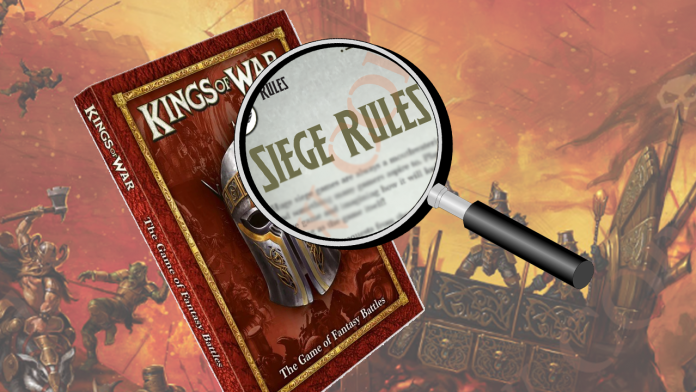G’day Goonhammer readers! The new Kings of War Gamer’s Compendium is bringing all of the rules needed to play the core game, but it’s also stacked with extra rules for new battle modes. Already we have revealed how to play massive battles in Legendary Games, but now we want to discuss how fortifications and castles can be integrated into battles with the new Siege Rules.
What are Sieges in Kings of War?
Sieges are asymmetric battles in which one force, the Defender, occupies a castle, while another, the Attacker, strives to defeat them. These are usually epic battles with bespoke terrain in which the units can garrison to mount a defense. The centerpiece for many an epic movie has been a siege battle; Helm’s Deep in Lord of the Rings: The Two Towers (2002) or Troy in Troy (2004). It is the dream of many a wargamer to recreate the feeling of these epic scenes, and so Mantic has done this, and more!
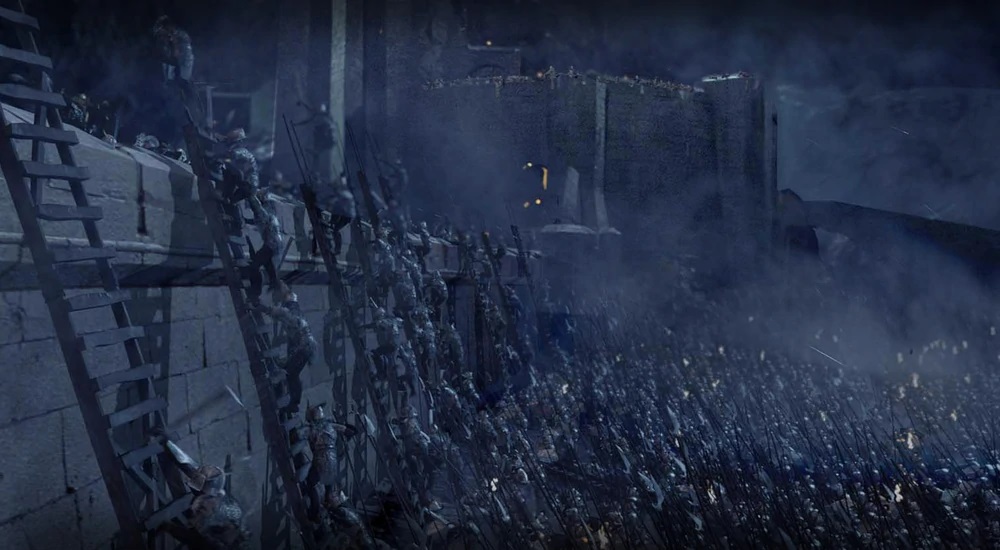
Being King of the Castle
For the purposes of Kings of War, a typical castle is made up of two towers and three wall segments, one of which should contain a gate. The walls should be able to support a horde of Infantry, while the towers should be big enough to at least hold a troop of Infantry. These are the minimum requirements, with bigger and more fortifications perfectly acceptable for larger games.
There are two suggested layouts for the castle. One uses standard deployment with the castle situated in the middle of the Defender’s deployment zone, like a little fort. The other mode puts deployment zones along the short edges of the table, and has the walls spanning the width of the battlefield à la Hadrian’s Wall.
The Anatomy of Walls
These fortifications are not just for show. First, the Attacker’s need to physically reach the Defender’s, so only units of Height 5 or those with Flying can make attacks against defending units. For the shorter denizens of Pannithor, there is Siege Equipment to help (like ladders). Either way, attacking through battlements isn’t easy, there’s no Thunderous Charge bonus, and doubling or tripling attacks only happens in rare situations. The grind is real!
The Defender’s cannot rely on the walls indefinitely for they, too, can be destroyed. Each wall section has a unit profile, with a measly Nerve of 8/10, but a Defense of 7+(!!!). Not only does this necessitate the use of stronger units, but only Monsters, Large Infantry and Large Cavalry can begin dismantling castle walls.
The most fun rule in Siege (at least for Cytoplasm) is that when a wall is wavered, it means it’s literally falling apart, damaging the garrisoning unit (they fall off or are invariably crushed by debris). Each turn after the wall must take a Nerve Test as it continues to crumble and shudder. If the wall routs then it is removed and so are the units garrisoning it. Complete destruction!
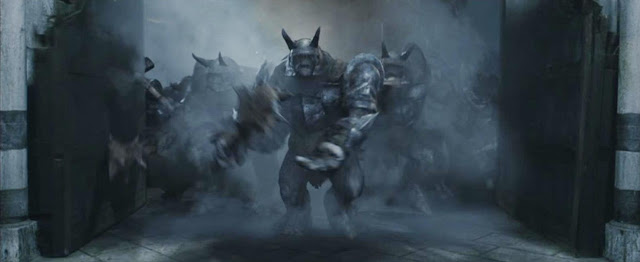
The castle wall section with a gate provides a means through which the Defender’s can sally forth, but also acts as a point through which standard infantry can make their assault. The gate’s Nerve of -/17 and Defense 6+ isn’t an easy task, but at least any unit can attack it. Once destroyed the Attacker can charge units inside the castle, but will be charged over (or through!) an obstacle; taking down a castle is never easy, especially when going in through the front door.
Scenarios for Sieges
It will come as no surprise that the objectives for Attackers and Defenders will differ, indeed there are three objectives provided for each that are chosen at random at the start of the game. The Attackers can achieve victory by capturing the castle (greater Unit Strength inside the walls), destroying the castle or killing the Defenders. Likewise, the Defenders can win by killing the Attackers, but also repelling the enemy or establishing supply lines (a string of objectives from the castle) are possible win conditions. If no one completes their objectives, the battle is a draw, which reflects what most sieges are the majority of the time.
Preparing Armies for the Siege
First off is deciding who is Attacker and Defender. Unlike in a normal game of Kings of War, Attackers and Defenders have different options in their army building:
- The Attacker gets a nice list of extra stuff to help in taking down those pesky walls, an extra 25% of the total points of their army to buy Offensive Siege Equipment.
- The Defender gets the aforementioned walls, but can spend 25% of their point limit on Defensive Siege Equipment.
So, in a 2000 point game, the Attacker gets 500 points out of 2500 points to spend on the new equipment, while the Defender gets to spend 500 out of 2000 points.
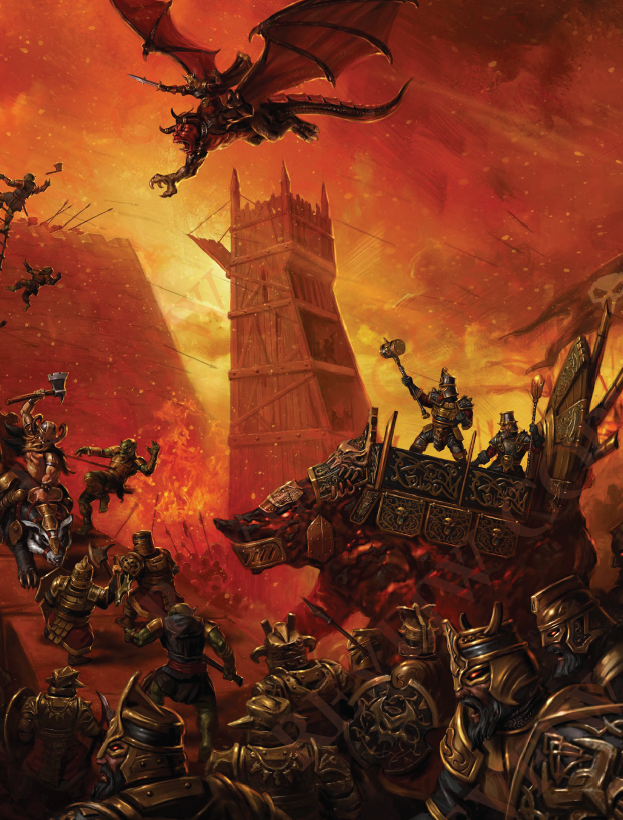
Castle Crashers (Attacker’s Equipment)
Bomb Wagon
The evocative scene where the Uruk-hai blow up a section of Helm’s Deep can now be recreated. Instead of one lone Beserker, the Bomb Wagon is perfect for taking out the Defender’s walls. A Goblin Blaster but better with Melee 2+, this thing will tear down those walls. But also like a Goblin Blaster, it is an easy target for ranged attacks, so a Defender should aim to stop that wagon!
Wallbreaker Artillery
Another standard piece of equipment from the sieges of Hollywood and history, Wallbreaker Artillery is there to represent any war engine that exists to take down walls, from the great Bombard to the mighty Trebuchet (that can launch a 90 kg projectile over 300 m). There’s no taking this if you’ve brought other War Engines in your army, but it is a nice option for those factions that don’t have any.
Wallbreaker Artillery is not dissimilar from standard war engines, with Blast (D3+2) Piercing (3) and Reload, but also gets +1 to hit and ignores Line of Sight when targeting Castle Walls.
It is also currently missing a range distance, but given these are rules for Narrative play, letting it shoot the walls at any distance seems reasonable. 
Unit Upgrades
As you might expect, you can take all the reasonable siege options as an Attacker. Ladders, Battering Rams and Siege Towers can be used to upgrade single units with greater ability to take on those walls and gates. These upgrades can be taken multiple times, so for armies composed of mostly infantry, there are ways to get over (or through) those walls.
Up with the Drawbridge (Defender’s Equipment)
The upgrades available to the Defender are truly impressive; 16 unique upgrades! These vary from the mundane enhancements including Sturdy Walls (+1 Defense), to the more arcane such as that of a Living Castle (Walls have Regeneration 5+). Some upgrades directly damage enemy units, like Tower Artillery, which provides a generic War Engine in one tower. Other upgrades enhance the units on the walls, for example This Is Our Castle! gives Rallying (1) to all Walls.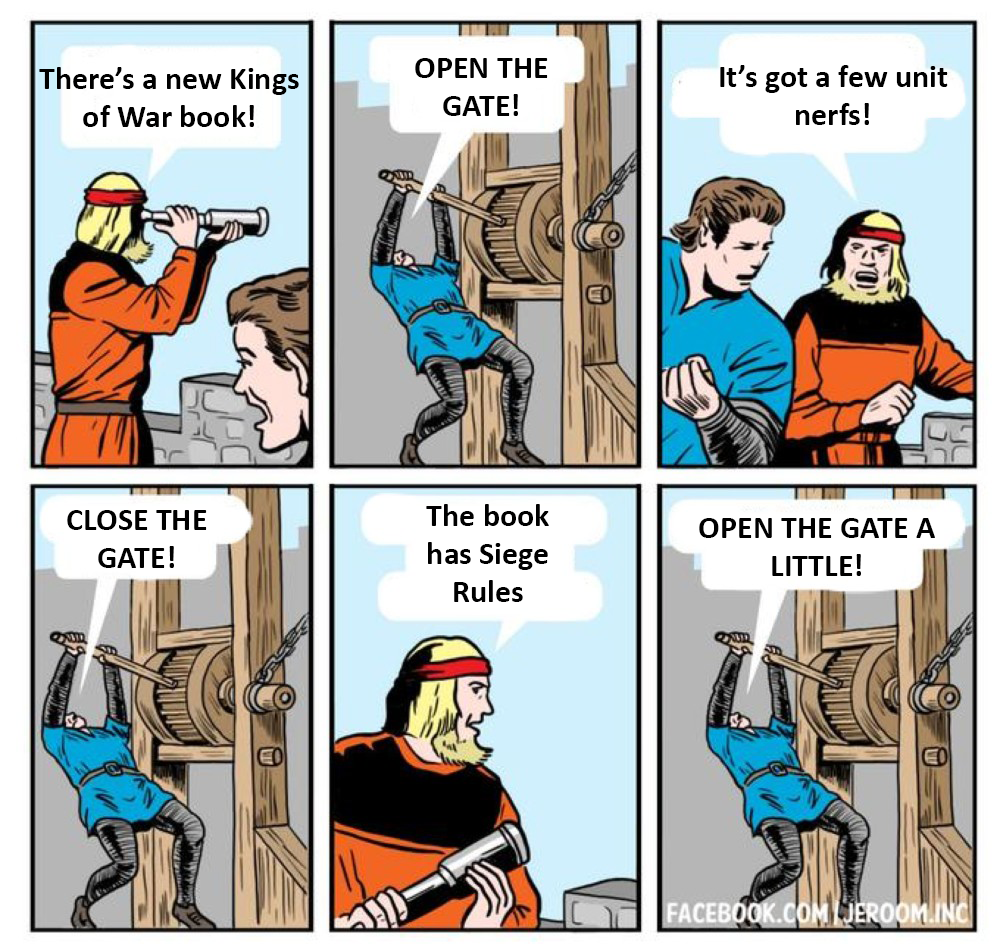
These modifications not only provide a means to improve the castle, but reflect the army that occupies it; a bastion of the Trident Realms will be vastly different to a fortress of the Imperial Dwarfs. To help, a handy table is provided showing which factions can take which upgrade, with most being entirely logical. Goblins can’t make Sturdy Walls, Undead can’t have a Living Castle, and Kingdoms of Men can take everything if they have enough points. In the end, only 25% of the points total can be spent on these upgrades, coming at the expense of the Defender’s total points, so choose wisely.
A Strong Narrative
Kings of War attracts many players with its tight ruleset and streamlined interpretation of the “rank and flank” wargame style, but as with any wargame the whole spectacle of models battling one another is inherently evocative of fantasy narratives. The inclusion of detailed rules for Legendary Games and Sieges enhance the narrative aspect of Kings of War to new heights.
We have had Siege Rules in Clash of Kings 2019, and had crazy magic in Halpi’s Rift (2020), but now we have monster creation, expanded Siege rules, and Rift magic all in the same book. Almost any scene in fantasy fiction can be recreated using these new additions, the only limitation being the models and terrain that you own, rather than the rules.
The Big Red Book is currently shipping out around the world, with some people already pouring over it. We reckon this is the best book they have released thus far, and is certainly worth the price tag. Indeed, we have ordered our hardcopies despite having a review copy just to have this weighty tome in our hands, rather than on our phones. We heartily recommend all players get this book, and we look forward to seeing how Kings of War evolves with all these new additions.
Have any questions or feedback? Drop us a note in the comments below or email us at contact@goonhammer.com.
